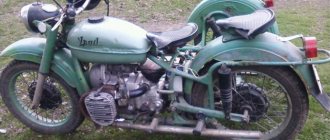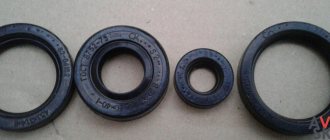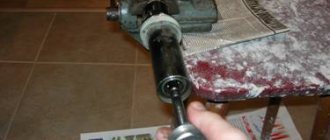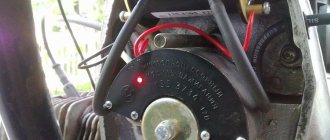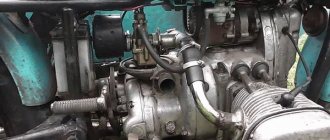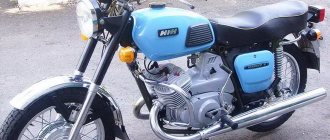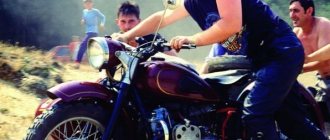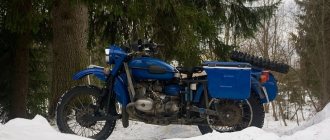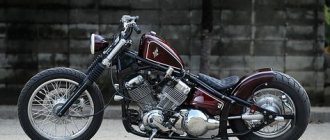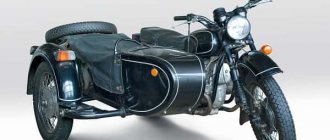MT8 engine of the Dnepr K-650 motorcycle
is a four-stroke air-cooled carburetor engine.
The engine uses an overhead valve timing mechanism, a cast crankshaft made of high-strength cast iron with removable lower connecting rod heads and replaceable connecting rod bearing shells. The design uses automotive-type inserts, interchangeable with the inserts of the Moskvich-408 car. The engine uses a forced lubrication system with centrifugal oil purification; bimetallic cylinders are used, which are more efficient than cast iron. Due to this, the engine has low thermal stress; the pistons in the cylinder are installed with a gap of 0.05 - 0.07 mm. The engine is reliable and durable.
Safety
MT 10-36 "Dnepr" is safer in terms of fire-fighting equipment. This became possible thanks to the presence of clamps on gasoline hoses. They prevent pipelines from jumping off and causing sparks. To reduce noise, a new atmospheric filter element and a more efficient muffler are used. This element is also interchangeable with analogues of other models. Only in this case it is necessary to install a new jet (180 cc/min instead of 200 cc/min). This design significantly reduces the noise of exhaust gases and prevents fuel from getting on hot parts.
The outer diameter of the muffler increased to 86 mm, and the volume increased by 1.6 times. The exhaust pipes and the internal configuration of the element have been transformed. The pipes on the cylinder are now secured with union nuts rather than clamps. This provides a tighter connection and helps remove a significant portion of the heat. After these improvements, the noise level of the unit decreased by 10 dB.
The MT10-36 engine is different from the MT10 engine
increased power up to 26.5 kW (36 hp). This was achieved by increasing the diameter of the intake valve head from 37 to 40 mm, using a camshaft with a new cam profile and increasing the compression ratio to 7.5 units. The crankshaft rotation speed is increased to 5600 - 5800 rpm. In this regard, the shape of the recess under the valves at the bottom of the piston has been changed. The MT10-36 engine uses a K301D carburetor, which differs from the K301B carburetor in the diameter of the diffuser and the increased throughput of the main fuel cylinder. Instead of the PM302-01 breaker, the PM302-A breaker is used with a new design of the ignition timing device.
content .. 31 32 36 ..MOTORCYCLE GEARBOX “URAL”, “DNEPR”
On the Ural and Dnepr K-650 motorcycles, a two-way four-speed gearbox model 6204 is installed. On the Dnepr motorcycles MT9, MT10-36, MV-750M MV-650, Dnepr-12, a two-shaft four-speed gearbox with reverse gear is installed and an automatic clutch release mechanism of the MT804 model.
All models of road motorcycle gearboxes have constant gear ratios in all four forward gears: 1 - 3.6 (36/10), 2 - 2.28 (32/14), 3-1.7 (29/17) , 4-1.3 (26/20). The gear ratio is obtained by dividing the number of teeth of the driven gear (secondary shaft) by the number of teeth of the drive gear of the primary shaft.
GEARBOX OF MOTORCYCLES “URAL”, K-750 AND K-750M
The gearboxes of the Ural and K-750, K-750M, K-650 motorcycles (Fig. 4.9) of the Kyiv Motorcycle Plant are unified. Since 1980, modernized gearboxes began to be installed on Ural and Dnepr motorcycles. The cam clutches on the secondary shaft were replaced with splined ones, the external parts of the gear shift mechanism were changed into a closed crankcase cavity and isolated from dirt getting on the working surfaces. Replacing claw clutches with splined ones has significantly reduced the possibility of self-disengaging gears. Placing all parts of the switching mechanism in closed cavities significantly reduced their wear, increased the reliability and durability of the mechanism. New models of Ural motorcycle gearboxes are created on the basis of previously existing ones through repeated modernization. The gearbox model with reverse gear, produced since 1987, has much in common with the previous one.
The gearbox housing consists of: crankcase 3, front covers 1, left 11 (Fig. 4.9) and right 19 (Fig. 4.10). The crankcase and front cover are load-bearing parts that absorb the main loads during operation of the gearbox. They contain shaft supports. The left and right covers are attached to the crankcase, on which the gear shift mechanism is mounted.
Rice. 4.9. Gearbox of motorcycles “Ural”, K-750, K-750M: 1 - front crankcase cover, 2 - primary shaft; 3 - crankcase; 4 — clutch release lever; 5 — manual gear shift lever on the right crankcase cover; 6 - secondary shaft; 7 — trigger shaft; 8 — buffer plug; 9 - drain plug; 10 — lower adjusting screw of the gear shift mechanism; 11 crankcase cover; 12-pedal gear shift; 13 - plug with filler neck
Rice. 4.10. Cross section of the shafts of the Ural, K-750, K-750M motorcycles: 1 - front cover flange; 2 — oil underwater washer with a tube, 3 — cavity in the middle of the shaft; 4 - secondary shaft; 5 — adjusting shims; 6 — ball bearing; 7 — front crankcase cover; 8 — crankcase; 9 — thrust washer; 10, 13, 14, 18 - gears, respectively 4, 3.2, 1 gears; 11, 17 clutches for 3rd, 4th, 1st and 2nd gears, respectively; 12, 16 — shift fork for 3rd and 4th, 1st and 2nd gears, respectively; 15 — splined coupling; 17 — clutch for engaging first and second gears; 19 — right crankcase cover; 20, 24 — driven and driving gears of the speedometer drive, 21, 37 — cuffs; 22 — elastic coupling disk; 23 nut; 25 — slider; 26 — rubber ring; 27 - thrust bearing; 28 — roller bearing; 29 — rod tip; 30,32, 33 — crown of 1st, 2nd, 3rd gears; 31 — rod seal; 34 — 4th gear gear, 35 — key; 36 - ball bearing; 38 - input shaft; 39 — clutch release rod; 40 — cuff coupling
content .. 31 32 36 ..
Since November 1978
Pistons with a head sphere radius of 72.5 mm were produced. They were installed on the MT10-36 engine when running on regular A-72 and A-76 gasoline with a compression ratio of 7.5 units. and on the engine of export motorcycles to run on high-octane A-93 gasoline with a compression ratio of 8.5 units. The distance from the piston pin axis to the outer surface is 48.2 mm.
Interesting: The 1967 Dnepr-1 motorcycle is the last survivor of the 12.
The shape of the groove for the exhaust valve in the piston has been changed. In order to maintain the compression ratio of the working mixture, a cylinder is installed on the MT10-36 engine, which differs from the cylinder of the MT8 and MT9 engines in the height of the installation size. The distance between the surfaces that are adjacent to the engine crankcase and the cylinder head is 107.7 + 0.14 mm
Piston MT10-36
Review Dnepr MT-10-36 (1978)
I also wanted to say a little more about the Dnieper.
Usually, young padawans began (in post-Soviet times - the 90s) their motorized transport journey with something small, namely some kind of moped (Karpaty, Riga), then came Minsk or some kind of Voskhod, then there was Izh and at the end of the path PS or Java/Cheset. If someone wanted more, then they bought a car or, in rare cases, a heavy motorcycle like the Ural or Dnieper (provided that they lived to that point or were healthy enough to continue operating equipment - what can you do, youth mortality is due to inability I have sent more than one soul to other worlds to drive motorcycles).
In this regard, my path as a motorcyclist was not entirely typical. Having learned to ride a motorcycle at the age of 14 in Izha, I immediately switched to MTshnik.
Since I didn’t have a license for a motorcycle, and somehow I didn’t want to run away from the guys at high speeds (I’d beat the motorcycle and injure myself), it was decided (after scratching the turnips) to come up with a cunning plan. Namely: escape routes from the car in which the valiant servants of the striped sticks could ride have been worked out. That is, in fact, for each car a route was made and detoured that it could not overcome. Off-road is our everything!!!:):):) Since the street is not paved in any way, then we will use what we have.
For painless escape from the Volga and UAZ, there was a narrow loophole between the post and the fence, through which a Moskvich (only classic) or a Zhigul (also a classic, but already catching with mirrors) could slip through. On the opposite side of this pillar there was a track so broken by tractors that it was only possible to catch up with me in Belarus. But since traffic police do not drive tractors, this route was recognized as good and suitable. For small cars (Tavria, Zhiguli, Moskvich) there were a couple more spots that they simply could not drive through due to the terrain. To be honest, it was impossible to drive a truck there without getting stuck - the motorcycle could only go along a narrow path along the fence (almost clinging to the fence :)), drowning the stroller in a huge puddle and wading up the wheel hub of the stroller in what should be water: )
In general, I settled for a draw with the state - that is, it does not pave the road to my house, and I do not owe them anything to legitimize my right to drive this equipment.
By the way, all these escape routes were useful only once, and not for me, but for my brother.
Okay, let's move on.
This motorcycle does not like rain - the electrics began to play around and if they came into close contact with the spark plug wires, they could get an electric shock. The right spark plug flooded a couple of times and did not work well - under load it runs on one cylinder, but the dynamics are not at all the same :(
The motorcycle's carrying capacity was clearly higher than what was specified in the passport: at least it carried a whole sidecar of sand-lime brick without any problems. We also dragged trees a couple of times. It was like this: my dad gave me and my brother a task to do, namely to drag two elms from the river to the house. It doesn’t seem like it’s too far to drag - about 200 meters through the garden, but damn, what a monster you have to be to cut a dried elm tree into logs and pull them by hand. In short, I brought the motorcycle up, took the chain stronger, tied the chain on the frame (near the motorcycle itself), then on a tree. Having backed up so that 4 meters of the chain were “for acceleration”, I drove my herd of horses forward. In general, 36 horses coped with the task quite well, but it all looked, of course, quite sour - the motorcycle is dragging a whole tree :), although we had to take a detour, that is, about half a kilometer, but that’s all bullshit compared to the ruts in which Almost hit a motorcycle. In general, if the road is level, then this is an elementary task, but if there are ruts, then the tree can jerk so hard that you fall through and you can tear off the pot.
The gear selector (near the left leg) in my Dnepr was double-shouldered. By the way, this is the most optimal design for use on rough terrain. Because the single-arm one must be switched by pulling the lever up, with your toes tucked under it. And at this moment (if you are driving across a field) you could injure your foot, since there is a bunch of rubbish, stones, and pieces of iron scattered across the fields. I know a couple of people who took a long time to treat their chassis after such jokes. And you always press the two-arm lever from top to bottom: when switching to upper gears with your heel, when switching to lower gears with your toe. Safety, damn it :)
Reverse gear! This wonderful device saved me a lot of nerves and effort. It is turned on by a small lever near the right foot. To turn it on, you need to go to neutral and shift it forward by hand. In principle, after getting a little used to it, I calmly turned it on and off with my foot, so you can consider this another foot gear :) By the way, chain motorcycles did not have a reverse gear, which also greatly inferior to the Dnieper.
By the way, regarding 36 horses, the data sheet stated “at least 36 hp.” at such and such speed and 72 gasoline,” that is, half of a Zhiguli engine - for such and such a mass 
The technical book also indicated 3 (three!) ways to drive and change gears with a faulty clutch (if, for example, the cable broke on the road). True, I have never tried any of them. Because after adjusting the carburetors there was no longer any faith in the book :)
I’ll say right away: this motorcycle was used purely for going to the river, and as a small truck. Because he really carried potatoes from the garden, and corn from the field, and much more.
What I liked about this transport was its simplicity and reliability. When I saw how the owners of Izha constantly dismantled their iron horses in order to bring them to a living state, I felt sorry for them and pleased that my grandfather bought such a correct hole :)
The safety of driving on the Dnieper with a stroller is much higher than on the Izha with a stroller. This is associated with a right turn. When you turn right, the sidecar of the motorcycle tends to rise. And in the villages there are plenty of perpendicular turns. But I got used to it, even at 60 km/h I entered such turns, letting off the gas (at the exit of the turn it was about 40-45 km/h), then I just stepped on the gas a little and again 60. This won’t work on Izha - he has The stroller is light and rises at any speed, even in 2nd gear. Especially if no one is sitting there.
The Dnepr's cross-country ability is quite good, if you get used to it, and also take into account the fact that it does not drive under tension - like the Niva, it must overcome obstacles at a swoop. Well, they are not afraid to “sink” the stroller - the main thing is that the drive wheel is on good ground. It will pull the stroller in any way;)
And besides, it’s quite light - I lifted it by the rear wheel myself without any problems - you could do the same with a stroller. In general, if you get stuck, then it’s as easy as shelling pears for the two of you to stand up, pick you up by the tail, drag it to the side, back it up, and continue on your way. This all applies to black soils. On sandy soils it drives worse - because it gets stuck, here you have to drive just tight so as not to break the wheel into the axle box. Well, and most importantly, it’s better to ride through the mud with several comrades who, if necessary, will pull out the motorcycle;)
Fuel consumption, if you didn’t drive fast, was about 6-7 liters. Not fast - it's 35-40 km/h. And we didn’t really have anywhere faster - and besides, there are few roads with good surfaces and, in principle, at those distances there’s really nothing to rush - well, I’ll arrive a minute earlier, so what? I'm not late for the plane. But when you drive around the village near the courtyards, I generally had 4th gear and 25-30 km/h as standard and my right foot over the (rear) brake pedal. Simply reasoning that children playing outdoor games always run forward, but looking back can jump out of any crack in the fence, then in order to prevent any problems associated with this, I decided to simply drive quietly and leisurely. Although many people put the needle on the Dnieper (the speedometer is set to 120 km/h), many of these pilots have been in the next world for a long time, which cannot but lead to reflection. And why ruin the equipment, if you drive on the Dnieper slowly, then it will serve its owner faithfully all his life. And if you drive it both in the tail and in the mane, then in six months it will fall apart.
Summarizing the above, I can say this: the Dnepr is a good helper for a person living in a village who constantly needs to carry or transport something. And it was just a pleasure to drive it - such power is under you, you pressed the trigger a little and it went like children to school.
My impressions from this motorcycle are the best: once a year before the start of the season I changed the oil, cleaned the filter, tightened the brakes (if necessary) and... and that’s it :)
The MT10-32 engine is based on the MT10-36 engine
Unlike its predecessor, it has increased torque at low and medium engine speeds, which significantly improves the traction and dynamic characteristics of the motorcycle for use in rural areas. The motorcycle's maximum highway speed is 105 km/h, maximum power has been reduced by 3 kW compared to the MT10-32, and the rotation speed at maximum power output has been lowered by 700 rpm. The performance of the MT10-32 engine is improved by using a camshaft with a modified cam profile. The camshaft of the MT10-32 engine is completely interchangeable with the shaft of the previous design, it can be installed on the MT9, MT10 and MT10-36 engines. On the MT10-32 engine, instead of the MT801-237 piston with a spherical bottom, a piston with an ejector, which has a flat bottom, is installed. The use of a new piston improved the conditions for the formation of the mixture in the combustion chamber and reduced thermal stress. In addition, the compression stage in the MT10-32 engine was reduced to 7.0 units, the installation size in the cylinder, compared to the MT10-36 cylinder. increased by 0.9 mm. New cylinders can be installed on all previously released Dnepr motorcycle models with MT engines. The upgraded MT10-32 engine uses K63T Carburetors.
Peculiarities
On the Dnepr MT 10-36, the gaps between the locking pads and the brake drum are adjusted as wear occurs. The process is carried out by tensioning the cable using a fitting and then turning the cams on the axis. This is the first time this design has been used on heavy bikes. The advantage of such a brake is the possibility of installation on any of the previous versions of the motorcycle. Also, this type of front brake can act as a parking brake. To do this, you just need to press the brake lever on the steering wheel and secure it with a special push-button latch.
The brake element and clutch levers end in spherical knobs with a diameter of 2 cm. They serve to prevent possible injuries. The front mudguard is flanged at the end, and the passenger footrests tilt up and back at an angle of 45 degrees. A lock that locks the steering wheel in the column acts as an anti-theft device.
